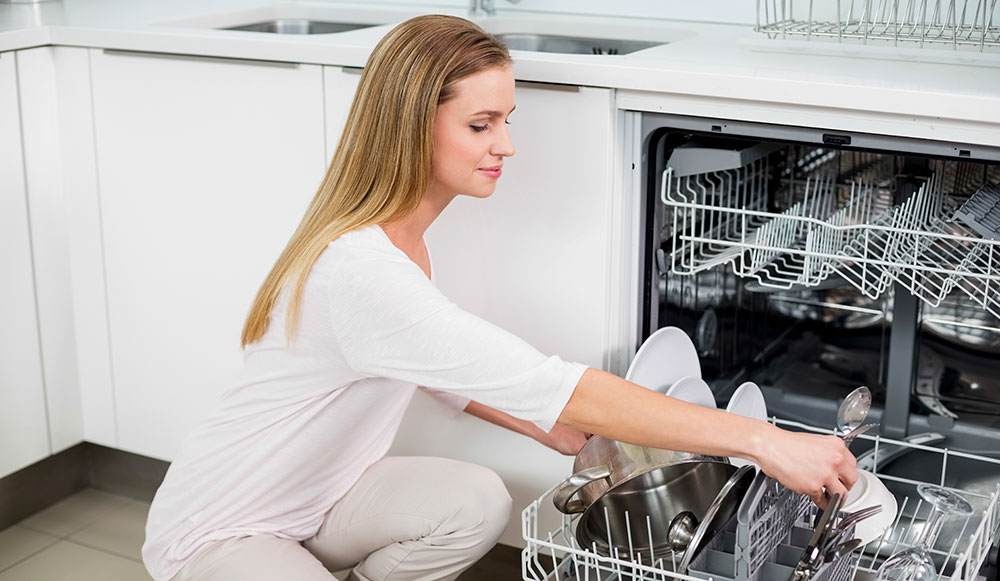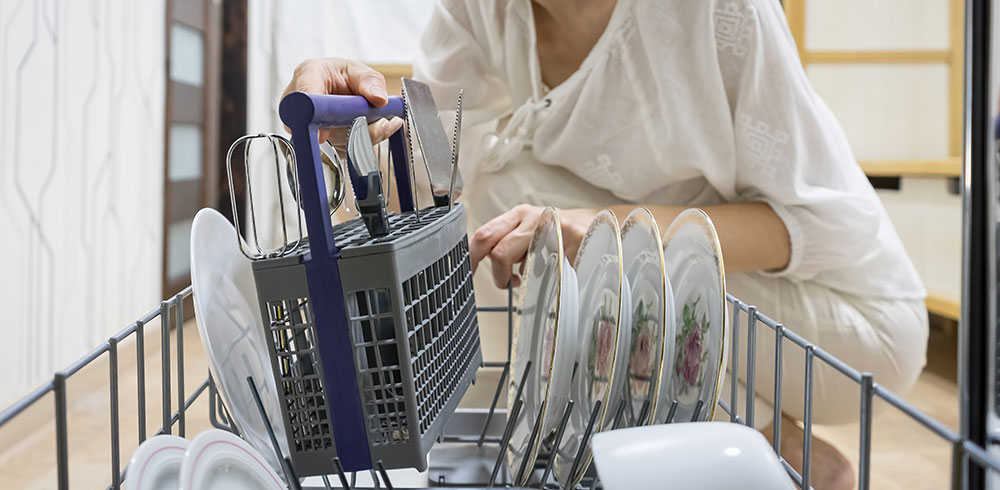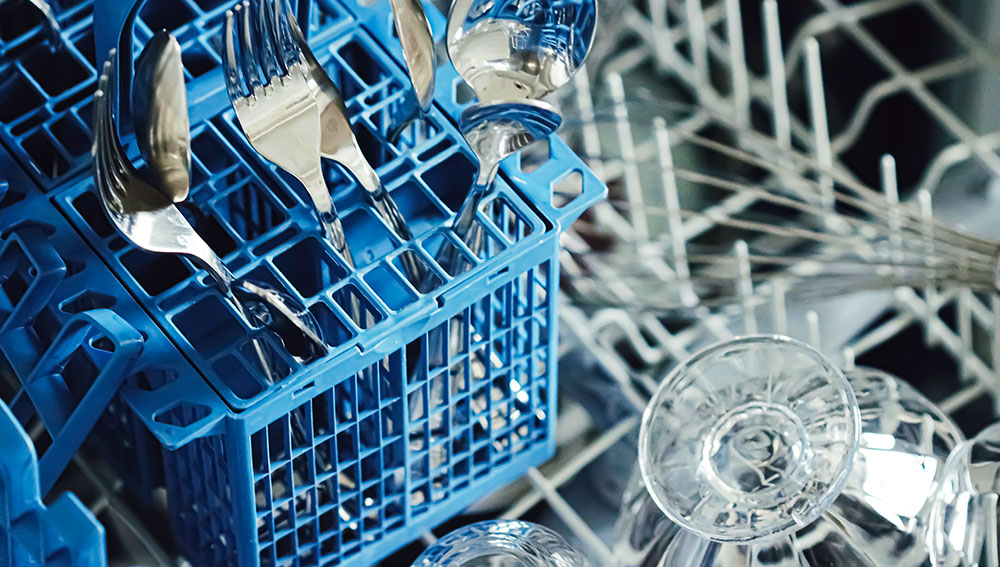Dishwasher
Why is my dishwasher leaking?
Why is the dishwasher leaking? Why does the dishwasher leak when it’s not running? As with any other electrical appliance, dishwashers sometimes don’t work properly.
The following are the common cause of dishwasher leaks and potential repairs.
1) The Door
The first place where leaks are found in the dishwasher is at the door. It’s the easiest component to analyze, and it opens and regularly closes so it’s easy for it to leak. Grasp the latch on the door to see if it is loose. If so, use a screwdriver to tighten them. As you do this, feel the area to see if there is any moisture near the latch, as this may indicate that the latch is slightly loose and needs to be tightened.
2) Dishwasher alignment
If you’ve recently moved the dishwasher for some reason and it started leaking, there may be an alignment problem. You need to level the dishwasher because if the dishwasher is not balanced, water can build up. The water will start to leak, and you will notice it on the bottom at some point. The first step should be to find a level to see if the dishwasher is properly arranged. If not, it could be due to a leak in the dishwasher.
You can adjust the height of each corner of the dishwasher with a wrench as the screws can be turned to start the process. Depending on your model, you may need to remove the step plate to access these adjustable screws. Hold it straight and adjust the device so that it is straight. When you’re done, check to see if the leak persists. If not, your problem is likely resolved.
3) Bathtub
The dishwasher is equipped with a bathtub. The bathtub is a sink at the bottom of each unit that allows water to drain off during the cycle. Over time, these tubs can wear out due to all of the soap’s water and chemicals. If the corrosion level is low in the bathtub, it can leak, and the water doesn’t need a large opening to escape. If you find that your bathtub is likely to leak, the leak can start under the unit.
If this is your problem, you can examine your model to see if the bathtub can be replaced or if the device should be replaced. You may need to seek professional help with this decision as knowing how to fix a leaky dishwasher is not the same as knowing when to make changes.
4) Valve
Every dishwasher has several valves that allow water to be introduced and removed after a cycle is complete. These valves must be connected to a water source. One reason the dishwasher may not work could be a problem with one or more valves. Fortunately, this is usually an easy solution as you need to buy and install replacement parts or kits.
Before doing this:
- Check the connection of each hose and valve.
- If you find these hoses are too old, consider replacing them.
- If you find loose connections, decide whether to tighten them or order and install replacement parts.
5) Soap
Usually, people wash the dishes before putting them in the dishwasher. If the dishes are heavily stained, they usually have to be scrubbed with normal detergent before placing them on the dish rack. This can cause problems depending on the amount of detergent used and the type of dishwasher.
If the dishwasher drips more than a few detergent drops while it is in operation, it will foam and expand. This expansion can cause the compartment to overfill, which can lead to leaks. Typically, this type of leakage occurs through the seal, as it is the most flexible component in the dishwasher. Do not use anything other than detergent in the dishwasher.
Why doesn’t my dishwasher drain?
Turning on the dishwasher to empty it, only to realize there is smelly sink water underneath, you will feel bad. Won’t you? Why doesn’t the dishwasher drain? Did it just happen by chance? You run the dishwasher again, and it turns out that there is still water on the bottom.
The question now is how to fix a dishwasher that has not been drained. Should you call the plumber right away? The answer depends on what you come up with.
Before you call, remove the water from the dishwasher so you can see all of the components. Check out five common reasons why there might be water on the bottom of a dishwasher.
| Causes | Solutions |
| Clogs in the drain hose |
1. Place a towel under the front panel to prevent water from spilling on the floor when the hose is removed. 2. Pull out the power plug to avoid electric shock. 3. Remove the front panel. 4. Remove the hose from the device and check for dirt. 5. If it is blocked, remove the residue and reconnect the hose. 6. If there are kinks, you may need to replace them because you cannot remove them. 7. If this is not the first time you have encountered a problem with the drain hose, it may be time to replace it as there is no reason to continue taking this risk. |
| The drain basket is full and not empty |
Remove the water and check if the drainage basket is clogged. If so, remove the residue and see if the remaining water drains off. If the water still doesn’t move, you need to take the next step and grab the plunger. Sometimes this can cause food stuck deep in openings that you may not be able to reach to drain away as smaller pieces melt together after passing through the basket. If you still can’t get rid of the standing water, you may need to call a professional. |
| The wrong detergent can clog the machine. |
Empty the dishwater and then rinse it out again with suitable soap. If it was wrong at first, the dishwasher should operate normally. |
| You forget to dispose of the food that builds up in the drain |
Carry out disposal. This may be all you need to get things back on track. |
| The dishwasher filter |
These filters need to be cleaned regularly and sometimes replaced. If you’ve checked everything else but you’re still unsure why the dishwasher hasn’t empty, pull out the filter, clean it, and run it again. If this doesn’t help, replace the filter. If there is still water at the bottom of the dishwasher, you may need to contact a professional. |
Why isn’t my dishwasher drying?
When the dishwasher turns on after a cycle of operation, you become frustrated when you find out that the dishwasher is still wet. Of course, you might be wondering why the dishwasher doesn’t dry out. Now is the time to investigate this problem and see what could happen.
Here are five ideas to consider as you figure out why dishwashers won’t dry.
1) The Heating Element
The heating element’s main function in the dishwasher is to increase the water temperature during the dishwashing process. The sink at the bottom of the appliance should also be heated so that the dishes can be washed.
Suppose the dishwasher doesn’t dry your dishes. At the end of the cycle, check to see if the appliance inside gets hot. If not, please check your heating element. It’s usually a long, horseshoe-shaped wire with plugs on both ends located on the back of the dishwasher. If it is damaged or the connection is loose, the heating element may be defective.
2) High limit thermostat
If the heating element is found to be installed correctly and not damaged, the next part to check is the high limit thermostat. The high-limit thermostat is also on the back near the top of the dishwasher. It has a cylindrical shape with brackets for installation on both sides. Its function is to turn off the heating element when the water reaches a certain temperature, which varies from manufacturer to manufacturer. This is necessary to prevent the dishwasher from overheating.
Failure of the high limit thermostat can cause the dishwasher to run at a lower temperature as the heating element turns off too quickly in one cycle. Therefore, the heating element’s insufficient function due to a malfunction of the thermostat can be the reason why your dishes are not dry. The only effective way to test the high limit thermostat is by using a multi-meter. Use this option to determine if the current is flowing through the part. If it doesn’t, you’ll need to replace it. If it does, then you need to keep searching for the possible cause of the damp dish.
4) Fan and Vent
When the vent is opened, and the fan starts running, another important step in drying the dishes occurs. The fan blows hot air and moisture from the dishwasher through the ventilation slots and makes the dishes dry. If any of these components fail, your dishes won’t dry out in the dishwasher.
These parts can be difficult to check. After stopping the wash cycle, you may need to check the dishwasher to see if the vents, usually located on the machine’s front, are open, and steam is coming out. If not, there may be a ventilation problem. If the dishwasher is turned off after a wash cycle, but the vents are open, the fan may not work properly. Fortunately, if you find that either or both of these parts are causing the dishes to not dry, you can luckily find and install replacement parts.
5) Detergent dispenser
If the detergent dispenser is defective or otherwise damaged, it may be because the dishes are not being dried. While the detergent does not seem to have anything to do with the dishes’ dryness, the truth is that everything has to run right for the dishwasher to work properly.
If the detergent dispenser leaks or does not open within a cycle, the appliance may not complete all the steps in the dishwashing process before shutting down. This means that your dishes won’t dry out. If this is the problem, it should be easy to locate and replace the damaged detergent dispenser.
This is how to stack your dishes.
The reason your dishes haven’t dried in the dishwasher may be because your dishes are stacked. You need to leave some space between the plates to allow the dry fan to blow hot air over the entire surface. If you don’t leave enough space between the bowls, air may not reach certain surfaces, and moisture may become trapped. If you tend to load the dishwasher with dishes, try running a cycle with fewer items to see if it works.
If you are not satisfied with performing any of these maintenance steps, you can always call a professional.
Why does my dishwasher smell?
You may be wondering why your dishwasher smells so bad.
Once you know the answers to these questions, you can begin solving the problem.
Below are five possible causes of dishwasher odor and some ideas on how to remove the odor.
1) Clogged food traps
A common cause of a bad smell in the dishwasher is the appearance of rotten old food somewhere in the appliance. If the dishwasher smells, the first thing to do is check the food collector at the bottom of the bathtub. There is a hole in there to capture the drain from the cleaning cycle. After the dishwasher is dry, pull out the lower basket to see if there is an old food collection tank in the basket.
If you can’t see the food on the surface, pull the basket out as far as you can, then continue digging into the opening to see if there’s anything there. Be careful with this – if you have broken glass in your dishwasher, there may be dirt in the food collector.
In some cases, you can extend the food trap’s opening to remove any waste that may be generated. Either way, removing old foods from the dishwasher should help reduce or eliminate unpleasant odors.
2) The drain hose is damaged
If there is a problem with the drain hose, it could cause an odor in the dishwasher.
If possible, pull the dishwasher away from the wall and look for bends, kinks, or other problems so that material can easily flow through the hose. Try to straighten the hose to make sure the material can get smoothly from one end to the other. If your drainpipe is too damaged to be straightened, you may need to replace the parts yourself or ask a professional for repair.
3) Poorly placed drain hose
Even if your drainpipe isn’t kinked or clogged with food waste, it could cause the dishwasher odor. If the drain hose falls from the back of the unit and runs across the floor and then moves up towards the sink, gravity may be against you.
If the drain hose is slack, try repositioning the hose. Ideally, the drain hose extends from the dishwasher into the sink so that gravity can do most of the work. Unless dirty water and food debris have to be handled “uphill,” they are less likely to get stuck and create an unpleasant odor in the hose.
4) Your Disposal
After all, the cause of the dishwasher odor might have nothing to do with the dishwasher. As mentioned above, the drain hose connects your equipment to the garbage disposal in the sink. If food is trapped at your disposal, clogged food can prevent the dishwasher from running through properly.
Dispose of your trash thoroughly and make sure there is no food left in it. If there is more food to process or not start normally, please use an Allen key to grind the enclosed food manually. If the problem is still not resolved, it may be time to repair or replace your disposal device. When you clear the clog, run the dishwasher again to see if there is an odor.
If you’ve gone through all of these steps but are still unsure how to remove the odor from the dishwasher, you may need to consult a service technician.


